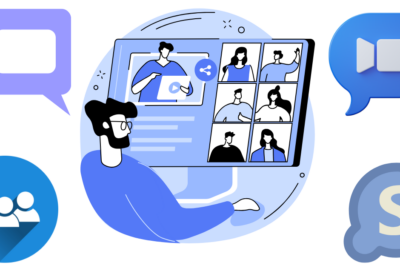How to Harness the Power of Computer Vision Tools
Computer vision tools made their appearance and profoundly impacted corporate workflows. This branch of artificial intelligence has advanced where computers can “see,” comprehend and analyze visual input. Image identification, detection, and segmentation can be performed using OpenCV, the TensorFlow Object Detection API, and Microsoft Azure AI.
The development of computer vision tools has made previously unattainable technologies within reach. Modern technical advancements are relied on by businesses of all sizes and sectors to provide them with a competitive edge. Ready to explore computer vision? Let’s start!
What are Computer Vision Tools?
Computer vision tools are software applications and libraries that enable computers to interpret and process visual information from the world, mimicking human visual perception. These tools use various algorithms to analyze photos and videos, extract valuable data, and make visual judgments. Computer vision tools are essential for picture recognition, object detection, medical imaging, and autonomous vehicles. They allow machines to “see” and understand their surroundings, enabling creative solutions and technology.
Popular Computer Vision Tools
1. OpenCV:
OpenCV is a freely available open-source library that contains over 2,500 machine learning and computer vision algorithms. Real-time image processing makes it adaptable and popular. It supports Python, C++, Java, Windows, Linux, and macOS. However, it needs more manual labor to set up and configure the environment and models, making it better for developers who understand computer vision.
OpenCV for Businesses
Retail: Retail businesses use OpenCV to create systems for customer behavior analysis, heat map generation, and in-store navigation. It can also be used in virtual dressing rooms to allow shoppers to try on garments virtually.
Healthcare: In the medical field, OpenCV is used for image analysis in medical imaging technology, like MRI machines. It aids in identifying diseases, segmenting medical images, and developing robotic surgery systems.
Security: Companies use OpenCV to build facial recognition systems for security purposes. It is also used in surveillance systems for motion detection, anomaly detection, and crowd monitoring.
Manufacturing: OpenCV finds extensive use in the manufacturing industry for quality control processes, where it helps in the identification of defective items on the production line.
Automotive: The automotive sector employs OpenCV to develop self-driving car technologies. It’s used in systems that recognize traffic signs, detect obstacles, and track other vehicles or pedestrians.
Marketing: OpenCV is used to develop systems for customer sentiment analysis, demographic estimation, and attention tracking, providing valuable insights for targeted advertising and product placements.
Agriculture: In agriculture, OpenCV is used for crop health monitoring, weed detection, and yield estimation by analyzing drone-captured images.
These are just a few examples of how companies utilize OpenCV. Its flexibility and powerful capabilities make it a popular choice for any business looking to incorporate computer vision into its operations.
2. TensorFlow Object Detection API:
This is a robust framework for developing, training, and deploying object detection models that Google has developed. It provides pre-trained models and training pipelines, allowing developers to customize models according to their needs. TensorFlow, particularly its Object Detection API, has significantly impacted the business world, enabling businesses to leverage machine learning and computer vision in their operations.
TensorFlow in The Business World
Retail: Retailers use TensorFlow for customer behavior analysis and inventory management. It’s used to develop systems that track customers’ in-store movements, analyze their buying behaviors, and predict future trends.
Healthcare: TensorFlow is widely used to analyze medical images for disease detection and diagnosis, enhancing the healthcare sector’s capabilities to provide better patient care.
Automotive: Companies in the automotive industry use TensorFlow to develop autonomous vehicle systems. It detects objects like pedestrians, signs, and other vehicles, contributing to safer and smarter transportation.
Security: TensorFlow’s object detection capabilities enhance security systems by recognizing faces or detecting unusual activities in video footage.
Manufacturing: TensorFlow aids in quality control in manufacturing units by identifying product defects on assembly lines, thereby ensuring optimal quality and reducing waste.
Agriculture: TensorFlow’s image analysis capabilities are used in precision farming to monitor crop health, detect pests, and optimize resource usage, helping to increase yield and efficiency.
Marketing: Businesses use TensorFlow to gain customer insights, like identifying popular products, tracking customer sentiments, and analyzing social media trends.
TensorFlow’s significance in business will grow even more critical as AI technology advances.
3. Microsoft Azure Computer Vision:
This cloud-based service provides developers access to advanced algorithms for processing images and extracting information. It can analyze visual features, detect objects, and read printed or handwritten text in images.
Microsoft Azure in The Business World
Retail: Azure Computer Vision can analyze and classify product images, helping in inventory management. It can also create descriptive captions for images, which helps enhance product catalogs and improve the accessibility of websites.
Real Estate: This tool can analyze property images and provide insights such as the type of property, its condition, and notable features. These insights can help real estate businesses price properties accurately and attract the right buyers.
Media: Media companies use Azure Computer Vision for content moderation by detecting potentially offensive or inappropriate content in images. It can also help categorize and tag vast media libraries, enabling faster and more accurate content discovery.
Manufacturing: In manufacturing, it detect defects in products or components by comparing them to standard images. This can significantly increase the efficiency of quality control processes.
Healthcare: Azure Computer Vision can analyze medical images and provide preliminary diagnoses, thereby assisting healthcare professionals in patient care.
Marketing: It can help businesses understand their audience better by analyzing social media images to track brand presence, understand customer sentiment, and observe trends.
Security: Security systems can be used for facial recognition, enhancing security measures in a wide range of settings.
The possibilities with Microsoft Azure Computer Vision are vast, and businesses across sectors can benefit from its ability to understand and interpret visual data effectively.
Tasks of Computer Vision Tools
Computer vision tools perform a variety of functions that benefit organizations across industries. Let’s examine how these duties benefit businesses:
Image Recognition:
Image recognition identifies objects in an image. Retailers, for instance, use this feature to tag and categorize product images, streamlining search and discovery for customers.
Object Detection:
Going beyond recognition, object detection locates and identifies objects in an image or video. In the automotive industry, it’s used in autonomous vehicles to detect obstacles, pedestrians, or other vehicles on the road.
Image Segmentation:
Image segmentation is the process of dividing one image into several segments. In the healthcare industry, this task helps identify regions of interest in medical images like MRIs, aiding in disease diagnosis.
Facial Recognition:
Facial recognition identifies or verifies a person’s identity using their facial features. It’s commonly used in security systems for access control and in social media platforms for tagging people.
Semantic Segmentation:
This task classifies each pixel in an image, providing a detailed understanding at the pixel level. It’s used in self-driving cars to understand road scenes.
Object Tracking:
In video surveillance, object tracking follows the movement of people or objects across frames, enhancing security.
3D Reconstruction:
3D reconstruction generates 3D models from 2D images, which is useful in the real estate industry for creating virtual tours of properties.
Optical Character Recognition (OCR):
OCR extracts text from images or videos. This feature is handy in data entry tasks, that automate digitizing printed documents.
Scene Understanding:
Scene understanding involves interpreting complex visual scenarios, which is useful in video analytics for customer behavior understanding or crowd monitoring.
As technology advances, computer vision capabilities in the commercial world will expand, providing even more disruptive prospects.
The Future of Computer Vision Tools
The future of computer vision tools is undoubtedly promising and packed with potential. Here’s a glimpse into what the future might hold for computer vision tools:
Increased Automation:
As machine learning and AI technologies evolve, computer vision tools can automate even more tasks, reducing the need for human intervention and boosting efficiency across various industries.
Improved Accuracy:
With the continual refinement of algorithms and learning models, the accuracy of computer vision tools in detecting and interpreting visual data will continue to improve. This will make them even more reliable for critical applications like healthcare diagnostics and autonomous vehicles.
Real-time Processing:
More real-time computer vision applications, such as real-time video analytics for security, traffic control, and live sporting events, will be possible as processing power improves.
Integration with IoT:
As the Internet of Things (IoT) grows, computer vision will become increasingly important in enabling intelligent objects to perceive and interact with their surroundings.
Augmented Reality (AR) and Virtual Reality (VR):
Computer vision is crucial for AR and VR technologies. As these technologies mature, we will see even more immersive and interactive virtual experiences.
3D Perception:
While computer vision has primarily dealt with 2D images, there is growing interest in 3D image processing and analysis. This will allow for a more thorough knowledge of settings and things.
Privacy-preserving Analytics:
As computer vision tools are often used in sensitive applications, there will be increasing emphasis on developing methods that respect and protect privacy.
With the right approach, the future of computer vision tools can lead to substantial benefits for businesses and society at large.
Conclusion
Finally, computer vision tools like OpenCV, TensorFlow Object Detection API, and Microsoft Azure Computer Vision are wide and promising. These technologies are changing how we see and interact with the world, opening up unlimited possibilities in healthcare, retail, automotive, and security.
Teaching machines to “see” and analyze visual input has far-reaching effects. These tools are projected to automate more, raise efficiency, improve decision-making, and solve complex problems as they change.
Harnessing computer vision’s full potential will transform our future. These tools can boost innovation and success in the digital age for companies that can adapt and incorporate them.
So, are you ready to investigate computer vision and see how it changes your business?




